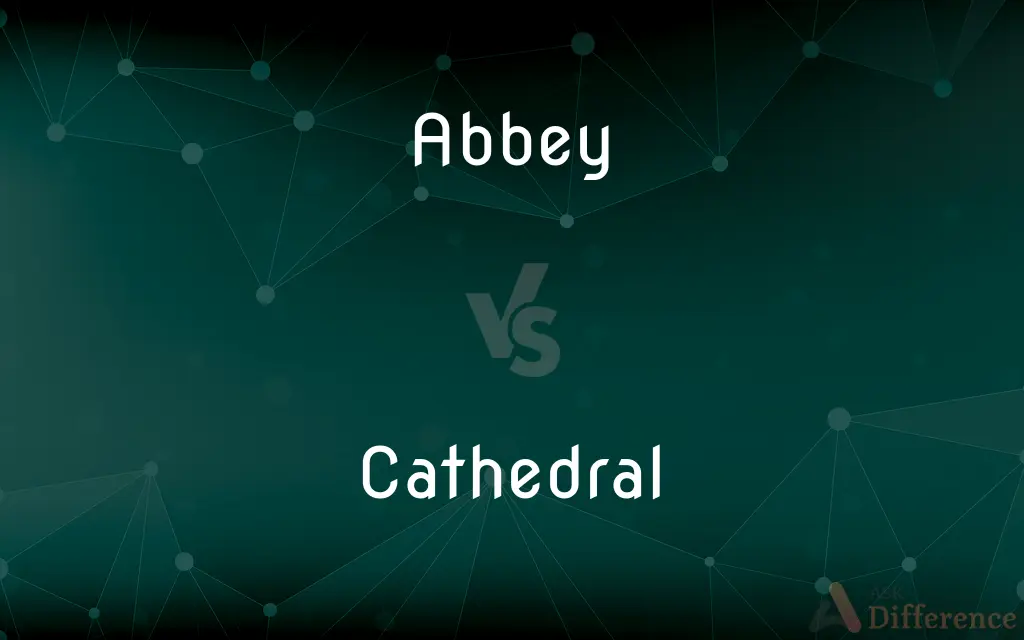Abbey vs. Cathedral — What's the Difference?
By Maham Liaqat & Urooj Arif — Updated on March 24, 2024
An abbey is a complex including a monastery or convent, centered around an abbey church, where monks or nuns live in community. A cathedral is a church that contains the cathedra, or bishop's seat, making it the central church of a diocese.

Difference Between Abbey and Cathedral
Table of Contents
ADVERTISEMENT
Key Differences
Abbeys are primarily religious communities where monks or nuns live, work, and worship, often secluded from the world. These communities are dedicated to prayer, contemplation, and sometimes work like farming or education, with the abbey church as their spiritual center. In contrast, cathedrals serve as the principal church within a diocese, distinguished by housing the cathedra, the official seat of the bishop, symbolizing his teaching authority and governance over the diocese.
While abbeys may be located in rural or remote areas to facilitate a contemplative life for their communities, cathedrals are usually situated in cities or towns, serving as a central point for diocesan activities. This location reflects their role not only in religious worship but also in the administrative, social, and educational life of the community.
The leadership within an abbey is typically provided by an abbot or abbess, who is elected by the community and holds authority over the monastery's operations and spiritual welfare. On the other hand, a cathedral is led by a bishop, whose responsibilities extend beyond the cathedral itself to include oversight of parishes and clergy throughout the diocese.
Abbeys and cathedrals both play significant roles in Christian worship and community life but differ in their focus. Abbeys emphasize monastic community and a life dedicated to prayer and work under the Rule of their order, whereas cathedrals focus on serving as the bishop's seat and the liturgical heart of the diocese.
Architecturally, abbeys and cathedrals can both be impressive, often built in similar styles such as Gothic or Romanesque. However, cathedrals typically have more elaborate designs and are larger to accommodate larger congregations and significant ceremonies, reflecting their central role in the diocese.
ADVERTISEMENT
Comparison Chart
Definition
A complex with a monastery or convent and a church, home to a religious community.
A church that contains the bishop's seat, central to a diocese.
Primary Role
Community living, prayer, and work.
Diocesan administration, worship, and bishop’s authority.
Location
Often rural or secluded.
Typically in cities or towns.
Leadership
Abbot or Abbess.
Bishop.
Focus
Monastic life and community.
Diocesan spiritual and administrative center.
Architectural Style
Often significant but varies; designed for community use.
Elaborate and large; designed to accommodate large congregations and ceremonies.
Compare with Definitions
Abbey
A complex that includes living quarters, workspaces, and a church.
Westminster Abbey, though no longer a monastery, retains its title.
Cathedral
The principal church of a diocese, involved in liturgical and administrative activities.
The cathedral hosts the bishop's ceremonies.
Abbey
A religious community and its buildings where monks or nuns live.
The Abbey of Saint Gall is renowned for its library.
Cathedral
Historical buildings that are often the oldest in their regions.
Salisbury Cathedral holds one of the original copies of the Magna Carta.
Abbey
Historical or functional religious complexes with a church at their center.
The ruins of Fountains Abbey attract many visitors.
Cathedral
A church that houses the bishop's seat, central to the diocese.
St. Peter's Cathedral is a major pilgrimage site.
Abbey
A place for monks or nuns dedicated to prayer and work.
The monks at the Trappist abbey produce renowned beer.
Cathedral
Architecturally significant churches, often landmarks.
Notre-Dame Cathedral is famed for its Gothic architecture.
Abbey
Centers for religious life, often with significant cultural and educational contributions.
The abbey was known for its scriptorium in the Middle Ages.
Cathedral
Centers for worship, education, and community activities within a diocese.
The cathedral's community programs serve the city's needs.
Abbey
An abbey is a type of monastery used by members of a religious order under the governance of an abbot or abbess. Abbeys provide a complex of buildings and land for religious activities, work, and housing of Christian monks and nuns.
Cathedral
A cathedral is a church that contains the cathedra (Latin for 'seat') of a bishop, thus serving as the central church of a diocese, conference, or episcopate. Churches with the function of "cathedral" are usually specific to those Christian denominations with an episcopal hierarchy, such as the Catholic, Anglican, Eastern Orthodox, and some Lutheran churches.
Abbey
A monastery supervised by an abbot.
Cathedral
The principal church of a bishop's diocese, containing the episcopal throne.
Abbey
A convent supervised by an abbess.
Cathedral
A large, important church.
Abbey
A church that is or once was part of a monastery or convent.
Cathedral
Something that resembles a cathedral, as in grandeur or authority.
Abbey
The office or dominion of an abbot or abbess.
Cathedral
Of, relating to, or containing a bishop's throne
A cathedral church.
Abbey
A monastery or society of people, secluded from the world and devoted to religion and celibacy, which is headed by an abbot or abbess; also, the monastic building or buildings.
From 1199 to 1203 William Punchard was the abbot of the abbey of Rievaulx, which was part of the Cistercian order of monks.
Cathedral
Relating to or issuing from a chair of office or authority; authoritative.
Abbey
The church of a monastery.
Cathedral
Of, relating to, or resembling a cathedral
Tall trees whose branches met to form cathedral arches over the path.
Abbey
(British English) A residence that was previously an abbatial building.
Cathedral
Relating to the throne or the see of a bishop.
Abbey
The church of a monastery.
Cathedral
The principal church of an archbishop's/bishop's archdiocese/diocese which contains an episcopal throne.
Abbey
A church associated with a monastery or convent
Cathedral
(loosely or informally) A large or important church building.
Abbey
A convent ruled by an abbess
Cathedral
(figurative) A large, impressive, lofty, and/or important building or place of some other kind.
Abbey
A monastery ruled by an abbot
Cathedral
A large buttressed structure built by certain termites.
Cathedral
In certain right-wing conspiracy theories, the mainstream system or establishment of society, held to be liberal or leftist and to be working against the interests of the people or nation, which is both.
Cathedral
The principal church in a diocese, so called because in it the bishop has his official chair (Cathedra) or throne.
Cathedral
Pertaining to the head church of a diocese; as, a cathedral church; cathedral service.
Cathedral
Emanating from the chair of office, as of a pope or bishop; official; authoritative.
Now, what solemnity can be more required for the pope to make a cathedral determination of an article!
Cathedral
Resembling the aisles of a cathedral; as, cathedral walks.
Cathedral
Any large and important church
Cathedral
The principal Christian church building of a bishop's diocese
Cathedral
Relating to or containing or issuing from a bishop's office or throne;
A cathedral church
Common Curiosities
Can an abbey also be a cathedral?
Rarely, some buildings have served both roles, but typically they serve distinct functions within the Church.
Are abbeys always located in remote areas?
Historically, many were built in secluded locations to facilitate a contemplative life, though not exclusively.
What is the significance of the cathedral’s architecture?
Cathedral architecture is often grand and symbolic, reflecting its ceremonial importance and the diocese's spiritual authority.
What distinguishes an abbey from a cathedral?
An abbey is a monastic community with its church, whereas a cathedral is the main church of a diocese and the bishop's seat.
What is a cathedra, and why is it important?
The cathedra is the bishop's chair in a cathedral, symbolizing his teaching authority and governance over the diocese.
Can anyone visit a cathedral or abbey?
Most cathedrals and some abbeys are open to visitors, though parts of abbeys may be restricted to preserve the monastic life.
How is an abbot or abbess chosen?
Typically, the monastic community elects the abbot or abbess to lead and oversee the abbey's operations and spiritual life.
Why are cathedrals often in city centers?
Their central location facilitates their role in diocesan administration, worship, and as a community hub.
Who lives in an abbey?
Monks or nuns live in abbeys, dedicating their lives to prayer, community living, and often some form of work.
Do all dioceses have cathedrals?
Yes, every diocese has a cathedral as the central church and the bishop's official seat.
What is the role of a bishop in a cathedral?
The bishop oversees diocesan activities, administers sacraments, and provides spiritual leadership from the cathedral.
How do abbeys support themselves?
Historically through land endowments, agriculture, and now often through tourism, products made by the community, and donations.
What is the historical importance of abbeys?
Abbeys have been crucial in preserving knowledge, culture, and education through history, especially in the Middle Ages.
How do the functions of abbeys and cathedrals reflect their architecture?
Abbey architecture supports monastic life and work, while cathedral architecture accommodates large congregations, ceremonies, and serves as a diocesan symbol.
What activities take place in a cathedral?
Liturgical services, administrative meetings, educational programs, and community events are common in cathedrals.
Share Your Discovery

Previous Comparison
Amaranth vs. Quinoa
Next Comparison
Lodge vs. HotelAuthor Spotlight
Written by
Maham LiaqatCo-written by
Urooj ArifUrooj is a skilled content writer at Ask Difference, known for her exceptional ability to simplify complex topics into engaging and informative content. With a passion for research and a flair for clear, concise writing, she consistently delivers articles that resonate with our diverse audience.














































